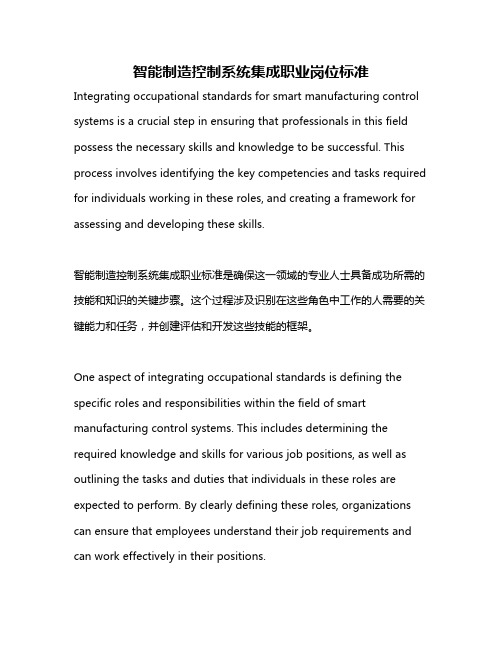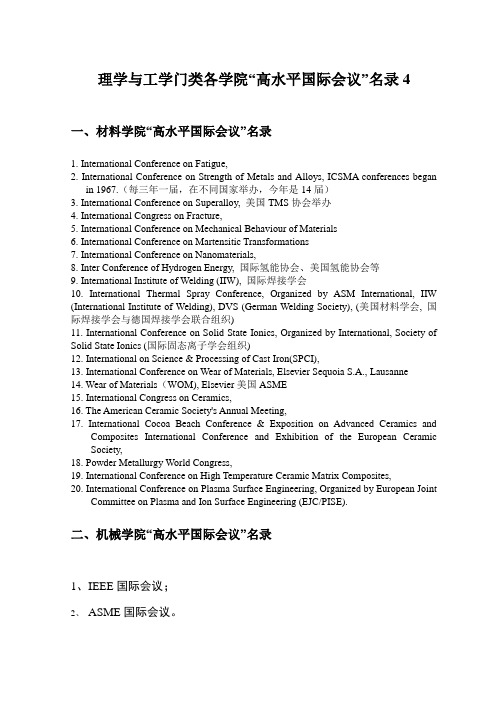ASM International Intelligent Control of Modular Robotic Welding Cell
智能制造控制系统集成职业岗位标准

智能制造控制系统集成职业岗位标准Integrating occupational standards for smart manufacturing control systems is a crucial step in ensuring that professionals in this field possess the necessary skills and knowledge to be successful. This process involves identifying the key competencies and tasks required for individuals working in these roles, and creating a framework for assessing and developing these skills.智能制造控制系统集成职业标准是确保这一领域的专业人士具备成功所需的技能和知识的关键步骤。
这个过程涉及识别在这些角色中工作的人需要的关键能力和任务,并创建评估和开发这些技能的框架。
One aspect of integrating occupational standards is defining the specific roles and responsibilities within the field of smart manufacturing control systems. This includes determining the required knowledge and skills for various job positions, as well as outlining the tasks and duties that individuals in these roles are expected to perform. By clearly defining these roles, organizations can ensure that employees understand their job requirements and can work effectively in their positions.智能制造控制系统集成职业标准的一个方面是定义智能制造控制系统领域内的具体角色和责任。
Agilis柔性送料器荣获SMTChina远见奖

间。MD T 送料器一直 以小巧轻便 ,利 于上料 和组装 而 Y AA
闻名于业 内。1 年前 ,MD T 向电子行 业介 绍A ii送 0 YA A g ls 料器后 ,很快就有了一大批 的拥蹇。 2 1年 ,MD T 针对大 型元 器件推 出全新A i i柔 0 1 YAA g s l 性送料器解 决方 案 ,这是在 原来M DT 专有 的A ii 送 YA A gl s 料器 上的扩 展 。现在,这种模组 方式可应对任 何卷 带料 和 管状料 , 比起传 统的送 料器可 大大减 少上料 和卸料 时 间。A i 柔性送料器能够处理编带宽度至 12m g ¨s 5m 的卷带 料;同时,可处理高至2m 的元器件 。 2m
配置振动盘上料模块的M9 2 可支持多达八个测试 T9 8 位 。 针 对 更 高 的 平 行 测 试 , M l iet 提 供 适 于 u tt s亦
ICr ir n ar e 的振 动 盘上 料 配 置 。
ห้องสมุดไป่ตู้
力 ,能满足I 基板与高端H I c D 的精密生产条件 。
借 助 成 熟 的M l iIa e T cn lg , lr u in u t—m g eh o oyU ta F so
上 料 模 块 延 续 了M 9 2 的 模 块 化 特 点 , 确 保套 件 交 换 简 T9 8 单 易行 。
奥 宝 全 新A 系统 提供 1 m检 测 能 力 OI u 5
CCF推荐的国际学术会议和期刊目录修订版发布

CCF推荐的国际学术会议和期刊目录修订版发布CCF(China Computer Federation中国计算机学会)于2010年8月发布了第一版推荐的国际学术会议和期刊目录,一年来,经过业内专家的反馈和修订,于日前推出了修订版,现将修订版予以发布。
本次修订对上一版内容进行了充实,一些会议和期刊的分类排行进行了调整,目录包括:计算机科学理论、计算机体系结构与高性能计算、计算机图形学与多媒体、计算机网络、交叉学科、人工智能与模式识别、软件工程/系统软件/程序设计语言、数据库/数据挖掘/内容检索、网络与信息安全、综合刊物等方向的国际学术会议及期刊目录,供国内高校和科研单位作为学术评价的参考依据。
目录中,刊物和会议分为A、B、C三档。
A类表示国际上极少数的顶级刊物和会议,鼓励我国学者去突破;B类是指国际上著名和非常重要的会议、刊物,代表该领域的较高水平,鼓励国内同行投稿;C类指国际上重要、为国际学术界所认可的会议和刊物。
这些分类目录每年将学术界的反馈和意见,进行修订,并逐步增加研究方向。
中国计算机学会推荐国际学术刊物(网络/信息安全)一、 A类序号刊物简称刊物全称出版社网址1. TIFS IEEE Transactions on Information Forensics andSecurity IEEE /organizations/society/sp/tifs.html2. TDSC IEEE Transactions on Dependable and Secure ComputingIEEE /tdsc/3. TISSEC ACM Transactions on Information and SystemSecurity ACM /二、 B类序号刊物简称刊物全称出版社网址1. Journal of Cryptology Springer /jofc/jofc.html2. Journal of Computer SecurityIOS Press /jcs/3. IEEE Security & Privacy IEEE/security/4. Computers &Security Elsevier http://www.elsevier.nl/inca/publications/store/4/0/5/8/7/7/5. JISecJournal of Internet Security NahumGoldmann. /JiSec/index.asp6. Designs, Codes andCryptography Springer /east/home/math/numbers?SGWID=5 -10048-70-35730330-07. IET Information Security IET /IET-IFS8. EURASIP Journal on InformationSecurity Hindawi /journals/is三、C类序号刊物简称刊物全称出版社网址1. CISDA Computational Intelligence for Security and DefenseApplications IEEE /2. CLSR Computer Law and SecurityReports Elsevier /science/journal/026736493. Information Management & Computer Security MCB UniversityPress /info/journals/imcs/imcs.jsp4. Information Security TechnicalReport Elsevier /locate/istr中国计算机学会推荐国际学术会议(网络/信息安全方向)一、A类序号会议简称会议全称出版社网址1. S&PIEEE Symposium on Security and Privacy IEEE /TC/SP-Index.html2. CCSACM Conference on Computer and Communications Security ACM /sigs/sigsac/ccs/3. CRYPTO International Cryptology Conference Springer-Verlag /conferences/二、B类序号会议简称会议全称出版社网址1. SecurityUSENIX Security Symposium USENIX /events/2. NDSSISOC Network and Distributed System Security Symposium Internet Society /isoc/conferences/ndss/3. EurocryptAnnual International Conference on the Theory and Applications of Cryptographic Techniques Springer /conferences/eurocrypt2009/4. IH Workshop on Information Hiding Springer-Verlag /~rja14/ihws.html5. ESORICSEuropean Symposium on Research in Computer Security Springer-Verlag as.fr/%7Eesorics/6. RAIDInternational Symposium on Recent Advances in Intrusion Detection Springer-Verlag /7. ACSACAnnual Computer Security Applications ConferenceIEEE /8. DSNThe International Conference on Dependable Systems and Networks IEEE/IFIP /9. CSFWIEEE Computer Security Foundations Workshop /CSFWweb/10. TCC Theory of Cryptography Conference Springer-Verlag /~tcc08/11. ASIACRYPT Annual International Conference on the Theory and Application of Cryptology and Information Security Springer-Verlag /conferences/ 12. PKC International Workshop on Practice and Theory in Public Key Cryptography Springer-Verlag /workshops/pkc2008/三、 C类序号会议简称会议全称出版社网址1. SecureCommInternational Conference on Security and Privacy in Communication Networks ACM /2. ASIACCSACM Symposium on Information, Computer and Communications Security ACM .tw/asiaccs/3. ACNSApplied Cryptography and Network Security Springer-Verlag /acns_home/4. NSPWNew Security Paradigms Workshop ACM /current/5. FC Financial Cryptography Springer-Verlag http://fc08.ifca.ai/6. SACACM Symposium on Applied Computing ACM /conferences/sac/ 7. ICICS International Conference on Information and Communications Security Springer /ICICS06/8. ISC Information Security Conference Springer /9. ICISCInternational Conference on Information Security and Cryptology Springer /10. FSE Fast Software Encryption Springer http://fse2008.epfl.ch/11. WiSe ACM Workshop on Wireless Security ACM /~adrian/wise2004/12. SASN ACM Workshop on Security of Ad-Hoc and Sensor Networks ACM /~szhu/SASN2006/13. WORM ACM Workshop on Rapid Malcode ACM /~farnam/worm2006.html14. DRM ACM Workshop on Digital Rights Management ACM /~drm2007/15. SEC IFIP International Information Security Conference Springer http://sec2008.dti.unimi.it/16. IWIAIEEE International Information Assurance Workshop IEEE /17. IAWIEEE SMC Information Assurance Workshop IEEE /workshop18. SACMATACM Symposium on Access Control Models and Technologies ACM /19. CHESWorkshop on Cryptographic Hardware and Embedded Systems Springer /20. CT-RSA RSA Conference, Cryptographers' Track Springer /21. DIMVA SIG SIDAR Conference on Detection of Intrusions and Malware and Vulnerability Assessment IEEE /dimva200622. SRUTI Steps to Reducing Unwanted Traffic on the Internet USENIX /events/23. HotSecUSENIX Workshop on Hot Topics in Security USENIX /events/ 24. HotBots USENIX Workshop on Hot Topics in Understanding Botnets USENIX /event/hotbots07/tech/25. ACM MM&SEC ACM Multimedia and Security Workshop ACM。
机械工程中的人工智能

机械工程中的人工智能本文由赛迪研究院《环球新工业》编辑部翻译节选自德国机械设备制造业联合会发布的《机械工程中的人工智能——观点和行动建议》报告。
该报告预测了欧洲与德国人工智能未来发展前景,提出了政治策略建议。
政治、媒体和工业高度重视“人工智能”,人们既对它寄予厚望,也讨论它的风险和应对风险的政治措施。
机械类企业是人工智能技术的主要用户,同时为工业解决方案的供应商,他们也是在产业价值链中推广和应用人工智能的核心环节。
机器和设备以嵌入式人工智能的形式,将人工智能技术带给用户,带进各行各业,机械工程在机器人、自动化、传感器技术等人机协作的高效整合和责任设计中积累经验。
德国机械设备制造业联合会必须支持会员企业应用,但是在政治领域和社会环境中,想要扩大人工智能技术接受范围并形成社会体系,以事实为依据进行理性讨论也很重要。
机械工程:用户和人工智能技术的放大效应对于机械工程而言,人工智能首先是获得保持世界领先地位的机会。
人工智能有助于提高工作效率,开发《机械工程中的人工智能——观点和行动建议》报告封面出新型商业模式,嵌入式人工智能解决方案的智能化功能还可以优化生产流程,扩大机器的使用和服务范围。
人工智能将决定机械工程未来产品和流程的影响力。
因此,构建卓越人工智能的基础既要依靠现有技术专长,也要依靠应用领域专长,机械工程以此为基础,在跨行业和跨部门人工智能的应用中都将发挥举足轻重的作用。
这不仅对机械工程类企业及其客户有好处,在节约材料和能源,完善决策,控制资源短缺和气候变化等问题上也有巨大潜力。
另一方面,如果不能成功利用人工智能带来的机会,欧洲工程类企业的领先地位肯定会下滑,输给世界其他地方的竞争对手。
因此,企业、机械研究机构和政策制定者必须把人工智能整合到机械工程中。
机械工程还必须勇敢承担引进新技术的责任——不论是保障机械安全,还是与社会的沟通合作。
但是德国机械设备制造业联合会认为,人工智能并非独立的全新政策,而是有横向意义的关键技术。
理学与工学门类各学院“高水平国际会议”名录4

理学与工学门类各学院“高水平国际会议”名录4一、材料学院“高水平国际会议”名录1. International Conference on Fatigue,2. International Conference on Strength of Metals and Alloys, ICSMA conferences beganin 1967.(每三年一届,在不同国家举办,今年是14届)3. International Conference on Superalloy, 美国TMS协会举办4. International Congress on Fracture,5. International Conference on Mechanical Behaviour of Materials6. International Conference on Martensitic Transformations7. International Conference on Nanomaterials,8. Inter Conference of Hydrogen Energy, 国际氢能协会、美国氢能协会等9. International Institute of Welding (IIW), 国际焊接学会10. International Thermal Spray Conference, Organized by ASM International, IIW (International Institute of Welding), DVS (German Welding Society), (美国材料学会, 国际焊接学会与德国焊接学会联合组织)11. International Conference on Solid State Ionics, Organized by International, Society of Solid State Ionics (国际固态离子学会组织)12. International on Science & Processing of Cast Iron(SPCI),13. International Conference on Wear of Materials, Elsevier Sequoia S.A., Lausanne14. Wear of Materials(WOM), Elsevier美国ASME15. International Congress on Ceramics,16. The American Ceramic Society's Annual Meeting,17. International Cocoa Beach Conference & Exposition on Advanced Ceramics andComposites International Conference and Exhibition of the European Ceramic Society,18. Powder Metallurgy World Congress,19. International Conference on High Temperature Ceramic Matrix Composites,20. International Conference on Plasma Surface Engineering, Organized by European JointCommittee on Plasma and Ion Surface Engineering (EJC/PISE).二、机械学院“高水平国际会议”名录1、IEEE国际会议;2、ASME国际会议。
澳创新:用心钻研,成就门“芯”

澳创新:用心钻研,成就门“芯”澳大利亚一直以来都是创新技术和科学研究的热门地区,其先进的科研设施和团队对于推动全球的创新起到了显著的作用。
在澳大利亚,有许多创新公司和机构在不断地进行新的技术研发,为世界的科技进步贡献自己的力量。
今天,我们就来了解一下澳大利亚创新企业的发展现状,并深入探讨一家澳大利亚的创新公司——门“芯”科技。
门“芯”科技成立于2014年,总部位于澳大利亚悉尼,在芯片设计和研发领域具有较高的知名度和影响力。
公司的创始人们在半导体领域拥有多年的经验和技术积累,致力于为全球客户提供高性能、低功耗的芯片方案,服务范围涵盖通信、物联网、人工智能等多个领域。
门“芯”科技凭借其创新的技术和优质的服务,在国际市场上迅速获得认可,并成功赢得了一大批忠实的客户。
除了在技术创新方面取得的成绩之外,门“芯”科技在企业管理和团队建设方面也表现出色。
公司注重人才的培养和引进,建立了一支技术过硬、经验丰富的团队,为公司的持续发展提供了有力的保障。
公司高度重视团队的创新能力和合作精神,鼓励员工勇于尝试新的技术和理念,激发团队的创造激情,不断挖掘潜力,在激烈的市场竞争中立于不败之地。
在产品方面,门“芯”科技一直以来都致力于为客户提供高性能、低功耗的芯片方案,满足客户不同领域的需求。
公司的产品涵盖了通信、物联网、人工智能等多个领域,得到了全球客户的一致好评。
公司拥有完善的产品研发体系和严格的质量管理体系,确保产品的质量和性能达到国际先进水平,为客户提供稳定可靠的产品支持。
在澳大利亚,像门“芯”科技这样的创新企业还有很多,它们正努力钻研,致力于打造更多领先的创新科技产品,为全球的科技进步做出更多贡献。
澳大利亚以其丰富的科技资源、完善的创新生态环境,吸引着越来越多的创新企业和科研团队前来发展,为世界科技的进步注入了新的活力。
相信在不久的将来,我们会看到更多源自澳大利亚的创新科技产品,为人类的生活和工作带来更多的便利和惊喜。
国际会议级别

99 學年度電機資訊學院教師出席國際會議等級清單
A 級(補助 3 萬元)
編號
主辦單位(國際組織)
會議名稱
International Conference on Technological Advances 21.
of Thin Films & Surface Coatings
Japan Society of Applied Physics, Electron Devices The International Symposium on Compound
Semiconductor" , Japan
會
20. The Korean Institute of Metals and Materials
International Conference on Electronic Materials and Nanotechnology for Green Environment
會議名稱
1. Association for Computing Machinery (ACM)
該國際組織每年所舉辦之洲際型區域年會 (附件 三)
Institute of Electrical and Electronics Engineers 2.
(IEEE)
該國際組織每年所舉辦之洲際型區域年會 (附件 四)
(IFAC)
IFAC World Congress
10.
International Conference LASER OPTICS
Optical Society of America (OSA) 11.
12. The Association for Information Systems (AIS)
智能制造十大核心技术

2016智能制造十大核心技术所谓(Intelligent Manufacturing,IM)是指由智能机器和人类专家共同组成的人机一体化智能系统,它在制造过程中能进行智能活动,诸如分析、推理、判断、构思和决策等,通过人与人、人与机器、机器与机器之间的协同,去扩大、延伸和部分地取代人类专家在制造过程中的脑力劳动。
使得企业的竞争要素发生根本性的变化,由之前的材料、能源两种资源为核心转变为材料、能源和信息三种资源为核心的竞争,从而产生了两种生产力,即以传统的材料和能源为代表的工业生产力和以信息为代表的信息生产力,这三种资源、两种生产力合在一起,形成未来企业竞争的核心。
1、赛博物理系统CPS:即赛博物理系统,Cyber-PhysicalSystems,是一个综合计算、网络和物理环境的多维复杂系统,通过3C(Computing、Communication、Control)技术的有机融合与深度协作,实现大型工程系统的实时感知、动态控制和信息服务,让物理设备具有计算、通信、精确控制、远程协调和自治等五大功能,从而实现虚拟网络世界与现实物理世界的融合。
CPS可以将资源、信息、物体以及人紧密联系在一起,从而创造物联网及相关服务,并将生产工厂转变为一个智能环境。
2、人工智能AI:即人工智能(Artificial Intelligence),它是研究、开发用于模拟、延伸和扩展人的智能的理论、方法、技术及应用系统。
它企图了解智能的实质,并生产出一种新的能以人类智能相似的方式做出反应的智能机器,该领域的研究包括机器人、语言识别、图像识别、自然语言处理和专家系统等。
3、增强现实技术AR:即增强现实技术,Augmented Reality,它是一种将真实世界信息和虚拟世界信息“无缝”集成的新技术,是把原本在现实世界的一定时间空间范围内很难体验到的实体信息(视觉、声音、味道、触觉等信息)通过电脑等科学技术,模拟仿真后再叠加,将虚拟的信息应用到真实世界,被人类感官所感知,从而达到超越现实的感官体验。
制造智能的智能工厂

制造智能的智能工厂作者:丁海骜来源:《数字商业时代》2017年第09期无论是VR设备、智能手表,还是应用最广泛的智能手机,智能硬件正在以一种全所未有的速度改变着人类的生活。
这一切,都源自电子领域近年来在技术方面飞速的发展——作为全球最大的半导体和发光二极管行业和封装设备供货商,ASM太平洋科技有限公司(以下简称ASM)为芯片制造商、IC制配工厂和消费电子产品制造商提供半导管制配设备。
换句话说,ASM正是那个加速我们智能化进程,为智能设备的生产提供加工设备的一家企业。
随着电子工业技术进步的不断加速,对于芯片、IP和电子产品企业来讲,其产品的更新速度更快,结构越来越复杂,响应市场时间缩短,销售服务周期更短……这就使得居于上游的加工设备提供商也要跟上这种进步的频率:需要在更短的周期内,为这些企业提供复杂度更高的设备。
几年前,ASM面临同样的问题。
作为行业当之无愧的领导者,ASM对产品研发和生产都投入了相当大的关注——ASM每年投入产品研发的资金达到销售额的10%,分布在包括香港、成都、新加坡、德国和英国等多个国家和地区产品研发中心拥有超过1300名员工。
相对地:ASM的6个大型生产加工工厂则分布在中国、马来西亚、德国等地——研发中心和生产加工工厂之间所存在的来自系统、地域的阻隔,使得当时的ASM在设计开发和生产加工之间也存在难以逾越的鸿沟。
ASM当面面对的挑战是:首先,虽然一直采用三维设计方式,但是三维模型中缺乏完整的生产信息数据(如几何公差),因此虽然采用了较为先进的设计方法,但是产品三维模型难以直接被应用到生产加工环节。
其次,当时在生产加工工厂所采用的加工方式对设计意图和设计内容无法在系统中抓取,事实上就使得产品数据几乎无法在CAD与CAM之间流动,导致设计与加工始终处在脱节状态。
因此每次来自产品研发中心的产品设计变革,都需要较长的时间才能传递到生产加工端——这也促使ASM意识到:需要从CAD/CAM一体化入手,才能彻底解决设计和生产自动化和效率的问题,进而升级为一家在业务和流程方面更具智能特征的企业。
电渣重熔过程智能控制的研究与应用

421前言电渣炉是冶金领域被广泛应用的一种精炼设备,电渣重熔(Electroslag Remelting 以下简称ESR )钢锭以其高纯度、组织质密和良好的机械性能而被广泛的应用在各种具有特殊要求的场合,在电渣炉熔炼过程中,熔炼电流的控制精度是决定ESR 产品质量的关键因素之一。
ESR 冶炼中,电流的过程控制因受工艺过程、机械特性,环境等因素的影响具有高度的非线性特性,难以用精确的数学模型表达,而且冶炼工艺要求电流输出量跟随期望的运动轨迹进行控制。
我公司原电渣炉控制系统是采用单结管电路直流拖动控制,其熔炼电流控制精度低,故障率高,维修难度大,且越来越难以满足现在多变的工艺要求。
因此,对电渣炉控制系统进行自动化改造已迫在眉睫。
非线性控制是控制理论中一个重要的研究分支,而人工神经网络理论为解决复杂的非线性、不确知系统开辟了一条新途径,目前在神经网络模型参考自适应控制、神经网络内模控制、神经网络非线性预测控制、混沌神经网络控制等方面已有不少重要研究成果,而且该方向的一些研究成果已在许多领域得到成功应用。
经充分收稿日期:2005-01-30;修回日期:2005-08-19作者简介:王达宇(1968-),男,河北人,高级工程师,工程硕士(在读),主要从事电渣炉冶炼及其设备控制研究.电渣重熔过程智能控制的研究与应用王达宇1,何国青2,宋万民2,康宇静1,刘进忠1(1.河北冶金科技股份有限公司,河北石家庄050031;2.石家庄铁道学院,河北石家庄050043)摘要:介绍了一种电渣炉智能控制方式,采用了PLC 程控及变频调速技术,并将人工神经网络理论和算法应用于电渣重熔的智能控制上,改善和解决了ESR 生产过程中重熔电流不稳定的状况。
应用结果表明该方法能够较好地实现电渣炉的智能控制。
关键词:电渣炉;人工神经网络;智能控制中图分类号:TM924.43;TP183文献标识码:A 文章编号:1002-1639(2005)06-0042-04Study and Application on Intelligent Control of the ESR ProcessWANG Da-yu 1,HE Guo-qing 2,SONG Wan-min 2,KANG Y u-jing 1,LIU Jin-zhong 1(1.Hebei Metallurgical Science and Technology Co .,Ltd .,Shijiazhuang 050031,China ;2.ShijiaZhuang Railway Institute ,Shijiazhuang 050043,China )Abstract :A kind of method for Intelligent Control of the process of Electroslag Remelting is introduced.The condition of unsteadiness of melting current is improved and solved by Control of PLC program and Technique of Frequency conversion and the algorithm of artificial neu-ral network (ANN )applied for Intelligent Control of ESR during the process of ESR.The smelting results show that the new method quite effective realize Intelligent Control of Electroslag furnace.Key words :electroslag furnace ;artificial neural network ;intelligent control7结论(1)本文采用数值分析方法计算了金属镁还原工艺中倒焰窑双排罐还原炉内单根还原罐内外的传热。
做ASM,人工投放还是智能投放?公司的基因很重要!

做ASM,人工投放还是智能投放?公司的基因很重要!作者:量江湖溪姐智能投放是一个宽泛概念,千万不要把它理解得太狭隘作为ASM智能投放第一个吃螃蟹的公司,我们推出了ASM智投平台,并首次提出智能投放概念,以区别于纯粹的人工投放。
提到智能投放,不是因为炒概念,赚眼球,那样不会长久。
而是基于公司大数据、机器学习与算法工程的基因、底子,多年来经验养成,决定了一家公司的战略方向以及优势。
在我们提出ASM智能投放理念之后,一些公司开始援引这一理念,提出人工智能AI,全自动化等等,也有一些同行跳出来呛声智能投放。
这里要纠正一个概念,智能投放是相对广义的概念,说现在智能投放做不了,这个理解本身是狭义的,我们目前在做的拓词、动态调价,都属于智能投放的范畴。
比如在拓词上,原来的ASO和现在的ASM在选词上是有不同的,就需要全新的逻辑和思路来操作,并结合机器学习进行智能拓词。
此外,有的小APP,本身质量不好的情况下,我们可以帮你预测出价、选词、做竞品分析,还有一些ASO基础工作也可以通过机器学习快速获得领域知识,使得优化更智能更高效,这些都是智能投放的一部分。
实际上,智能投放应用在ASM的部分其实也比较多,包括选词、动态出价、人群定向策略、竞品分析、反作弊等,一家公司不可能把所有部分都做了,并且做得很完美。
最终各家公司会有自己擅长的点,而所谓智能投放最终的目标是通过机器来参与完成一些事情,不是完全依赖于人工来做,这也是各家公司最终都会追求的一个效率问题。
谁又不是呢!之前我们了解到某公司在海外上线一个价格预测的ASM小工具,虽然经由技术研发人员对数据的抓取与分析,发现其价格预测是毫无根据的,但从这个工具的推出可以看出,一些公司也在向智能投放靠拢。
平台有全局数据但做不好局部优化,第三方平台反而能做好局部(智能)优化关于谷歌ad words,谷歌也好,苹果也罢,都属于平台方,平台方优势在于掌握全局数据,但是你得知道,拥有了全局数据反而做不了全局优化,这就是平台方的特点。
ASM全新推出SIPLACEPerformanceMonitoring

2 4l
蠡 塞 21 2 第 期 I o 年 月 1 2
导体设备供应商 ,在 中国拥有完善 的销售与服务体系及
扎实的客 户基础 。由美亚作为我们在 中国的战略合作伙 伴,也是我们进军中国市场 的重要策略之一。”
.
您将可 以更轻松地应用古老的流程优化准则,即 “ 无 您 法改进您不能衡量 的方面 ”。这一软件能够实时收集 有 关各种机器和生产线 的全部性能参数 。由于用户也可 以 在软件中为其重要 的关键性能指标 (P )输入 目标值, II (
随着全新SP AE P rom n eM n rn 的推 出, IL C e fr ac oi oig t
泰 时 自动 系统 携 手 美 亚进 军 中国市 场
全球领先 的半导体及 电子设备之设计及制造供 货商
泰时 自动系统有 限公司 ( ISA T MT O ) 日前正式与 D A U O AIN
优化 效率和加强亮度, 更提供极高可靠性能并且 降低光通
量单 位 的成本 。 ”A PA LH 能源 技术 副总裁 Rv h ta a i Ba k l
m ne M nt rn 的实 时比较功能 ,我们 能够支 持技术 ac o io ig 人 员和操作人员更有效地开展性能改进工作 。过去的经 验表 明,如果您 能够及时按班次提供偏差相关信息 ,操 作 人员将 能够更早采取相关应对措施 ,进而在许多情况 中能够取得更大 的成功 。由于 目标值可在各个生产环节
美亚科技确立战略合作伙伴关系 ,美亚科技将作为DA IS 在 中国地 区的主要代理 ,负责DA 旗 下产品在中国市场 IS
的经销事务 。
DA E 梁伟生表示 : “ IS CO 目前,中国在 全球半导体
全空间无人体系管控中心通用技术要求英文

全空间无人体系管控中心通用技术要求英文1. IntroductionThe development of unmanned control centers for all-territory space is an important aspect of modern technology. In order to ensure the smooth operation and safety of these control centers, it is crucial to establish universal technical requirements that can be applied across different spaces and environments. This document 本人ms to outline the general technical requirements for unmanned control centers in all-territory spaces in English.2. System Architecture2.1. The unmanned control center should have a modular and scalable architecture that can be adapted to different space environments and requirements.2.2. The system should be capable of real-time data processing, analysis, and decision-making.2.3. The architecture should be designed to facilitate seamlessmunication and integration with other systems and devices.3. Communication3.1. The control center should have reliable andsecuremunication capabilities, including both terrestrial and satellitemunication.3.2. The system should be able to handle a large volume of data transmission and ensure low-latencymunication.3.3. Themunication network should be resistant to interference and capable of operating in harsh environmental conditions.4. Sensing and Perception4.1. The control center should be equipped with advanced sensing and perception technologies, including radar, lidar, and optical sensors.4.2. The system should be capable of detecting and tracking objects in real-time, including moving vehicles, humans, and natural obstacles.4.3. The sensing and perception capabilities should be able to operate in diverse weather and lighting conditions.5. Control and Decision-making5.1. The control center should have autonomous control and decision-making capabilities to ensure continuous and safe operation.5.2. The system should be able to dynamically adapt and respond to changing environments and situations.5.3. The control and decision-making processes should be transparent and auditable.6. Power and Energy6.1. The control center should have robust and reliable power and energy supply systems, including backup and emergency power sources.6.2. The system should be energy-efficient and capable of optimizing power usage for different operational scenarios.6.3. The power and energy systems should be resilient to potential disruptions and f本人lures.7. Cybersecurity7.1. The control center should implement state-of-the-art cybersecurity measures to protect ag本人nst unauthorized access, data breaches, and cyber-attacks.7.2. The system should have advanced encryption and authentication mechanisms to ensure the confidentiality and integrity of data.7.3. The cybersecurity measures shouldply with international standards and regulations.8. Human-Machine Interface8.1. The control center should provide an intuitive and user-friendly human-machine interface for operators and administrators.8.2. The interface should support multi-modal interaction, including touch screens, voicemands, and gesture recognition.8.3. The system should be designed to minimize cognitive load and enhance situational awareness for operators.9. M本人ntenance and Support9.1. The control center should have built-in diagnostic and monitoring capabilities for proactive m本人ntenance and support.9.2. The system should be easily upgradable and expandable to amodate future technological advancements.9.3. The m本人ntenance and support processes should be well-documented and standardized.10. ConclusionIn conclusion, the above technical requirements outline the fundamental capabilities and features that are essential for the successful operation of unmanned control centers in all-territory spaces. By adhering to these requirements, organizations and developers can ensure the reliability, efficiency, and safety ofunmanned control center systems, thereby contributing to the advancement of technology in the field of unmanned space control.。
控制类外文期刊SCI-EI比较好投的有哪些

控制类外文期刊SCI,EI比较好投的有哪些作者: yanwei123456 发布日期: 2007-12-05控制类的SCI的都很难发,除非内容很好!如果不错就试试SIAM Journal on Control and Optimization.作者: mqlong 发布日期: 2007-12-05你研究具体哪方面?可以交流一下。
作者: Hongtan 发布日期: 2007-12-05International Journal of systems science, Internatioanl Journal of control, 应该要好中一点,atuomatica,IEEE AC, systems and control letters一般比较难中作者: ertuo104 发布日期: 2007-12-05ddfdd作者: qpl001 发布日期: 2007-12-05我现在主要做智能控制,研究随机梯度及投影算法有一段时间,研究了一种他们的快速收敛的方法,想发到国外的期刊上,速度快一点的作者: yanwei123456 发布日期: 2007-12-05建议找计算数学类的,applied numerical mathematics, Journal of computational and applied mathematics, applied mathematics and computation等等!不过现在数学类(包括控制类的)没有很快的,一般都得小半年才有审稿意见!系统与控制类投稿期刊整理AI MagazineAmerican Association for Artificial Intelligence (AAAI) PublicationsApplied Mathematical ModellingApplied Mathematics and ComputationArtificial IntelligenceArtificial Intelligence in EngineeringAutomatic control and computer sciences. 0146-4116Automatica. 0005-1098Automation and control. 0110-6295Automation and remote control. 0005-1179Chemical Design Automation NewsComputational Mathematics and Mathematical Physics Computational Statistics & Data AnalysisComputer Aided Geometric DesignComputer-Aided DesignComputers & Electrical EngineeringComputers & GraphicsComputers & Mathematics with Applications Computers in EngineeringComputers in IndustryControl ApplicationsControl Engineering PracticeControl, Optimisation and Calculus of Variations. Computing & control engineering journal.Control and instrumentation. 0010-8022Control engineering. 0010-8049Data & Knowledge EngineeringDecision Support SystemsDiscrete Applied MathematicsDiscrete MathematicsEcological ModellingEngineering Analysis with Boundary Elements Engineering Applications of Artificial Intelligence Expert Systems with ApplicationsElectronic Journal of Linear Algebra: Germany Electronic Journal of Linear Algebra: Israel Electronic Journal of Linear Algebra: Portugal Electronic Journal of Linear Algebra: USA Electronic Transactions On Numerical Analysis Future Generation Computer SystemsFuzzy Sets and SystemsIEE Computing & Control Engineering JournalIEE Proc. Control theory and applications 0143-7054 IEEE Control Systems MagazineIEEE Robotics and Automation MagazineIEEE Trans. Control Systems Technology. 1063-6536 IEEE SpectrumIEEE Transactions on Automatic ControlIEEE Transactions on Robotics and AutomationIFAC PublicationsImage and Vision ComputingIndustrial and Systems Control EngineeringInformation SystemsInstrumentation & control systemsInternational journal of adaptive control and signal processing. International journal of control.Information and Software TechnologyIntegration, the VLSI JournalInteracting with ComputersInternational journal of robotics & automation.International journal of systems automation, research & applications.Journal of Computational and Applied MathematicsJournal of Systems ArchitectureJournal of Systems and SoftwareJournal of Dynamic Systems, Measurement and ControlJournal of Dynamical and Control Systems:IsraelJournal of Dynamical and Control Systems:USAJournal of Mathematical Systems, Estimation, and ControlJournal of Process ControlJournal of Robotics and Autonomous systemsJournal of automation and information sciences.Knowledge-Based SystemsLinear Algebra and Its ApplicationsMathematics and Computers in SimulationMathematics and Computers in Simulation with Applied Numerical Math. Microprocessors and MicrosystemsMathematics of Control, Signals, and Systems:Netherlands Mathematics of Control, Signals, and Systems:USAMechatronicsModeling, Identification, and ControlNeural NetworksNeurocomputingParallel ComputingPattern RecognitionPattern Recognition LettersPerformance EvaluationRobotics and Autonomous SystemsSIAM Journal on Control and OptimizationSimulation Practice and TheorySystems and Control LettersTransactions of ASME. J. dynamic systems, measurement & control.SCI、EI收录的自动控制类期刊。
Intelligent Control Systems

Intelligent Control Systems Intelligent control systems are a crucial part of various industries,including manufacturing, transportation, and automation. These systems utilize advanced technologies such as artificial intelligence, machine learning, and data analytics to make real-time decisions and optimize processes. However, despitetheir numerous benefits, intelligent control systems also present several challenges that need to be addressed. One of the primary issues with intelligent control systems is their complexity. These systems often involve intricate algorithms and massive amounts of data, making them challenging to understand and maintain. As a result, there is a growing demand for professionals with the expertise to design, implement, and troubleshoot these systems effectively. Another significant problem is the potential for errors and malfunctions. While intelligent control systems are designed to operate autonomously, there is alwaysa risk of unexpected failures. These failures can have serious consequences, especially in critical applications such as autonomous vehicles or medical devices. Therefore, ensuring the reliability and safety of intelligent control systems is a top priority for researchers and engineers. Furthermore, intelligent control systems raise ethical and legal concerns. For example, in autonomous vehicles, there are questions about liability in the event of accidents. Additionally, the use of AI in decision-making processes may raise issues of bias and fairness. As these systems become more prevalent in society, it is essential to establish clear regulations and ethical guidelines to govern their use. Moreover, the implementation of intelligent control systems often requires significant financial investment. Companies must allocate resources for the development, integration,and maintenance of these systems. This financial burden can be a barrier for smaller organizations, limiting their ability to compete in the market and adopt the latest technologies. In addition, there is a growing need forinteroperability and standardization in intelligent control systems. As these systems become more interconnected, it is crucial to ensure that they can communicate and work together seamlessly. Establishing industry-wide standards for intelligent control systems will be essential for promoting compatibility and integration across different platforms and applications. In conclusion, whileintelligent control systems offer a wide range of benefits, they also pose significant challenges that need to be addressed. These challenges include complexity, reliability, ethical and legal concerns, financial barriers, and the need for interoperability. By acknowledging and actively working to overcome these challenges, the industry can fully harness the potential of intelligent control systems while mitigating their associated risks.。
SCI、EI收录的自动控制类期刊

48
0.795
Journal of Guidance, Control, and Dynamics v 21(制导、控制与动力学杂志)
0731-5090
153
0.400
IEEE Transactions on Systems, Man & Cybernetics Part C: Applications and Reviews v 28(IEEE系统、人与控制论汇刊)
SCI、EI收录的自动控制类期刊
刊名
ISSN号
EI收录篇
数98年
SCI收录
影响因子
Automatica v 35(自动学)英国
0005-1098
181
Automation in Construction v 8
0926-5805
57
Assembly Automation v 18(装配自动化)
0144-5154
30
Control Engineering(控制工程)
0010-8049
72
0.021
Control Engineering Practice
0967-0661
121
0.204
Control and Instrumentation
0010-8022
0.027
Control (Chicago,Ill) v 11
Optimal Control Applications & Methods v 19(最佳控制应用与方法)英国
0143-2087
18
0.170
International Journal of Adaptive Control and Signal Processing v 12(国际自适应控制与信号处理杂志)英国
ASM能力风暴机器人硬件和传感器介绍

能力风暴的传感器及处理(chǔlǐ)电路
传感器是将力或温度(wēndù)、距离等各
种工业(gōngyè)量改变为电信号输出的元件。
能力风暴上用了一下几中传感器:
1. 红外传感器
2. 光敏传感器
3. 碰撞传感器
4. 光电编码器 5. 声音传感器
第四页,共29页。
红外传感器
能力风暴(fēngbà2o只)运红用外了发射管( 970nm )和一 只红外接收模块(mó kuài)构成红外传感系统,主要用来检测 前方、左前方和右前方的障碍,检测距离(jùlí)范围为 10~80cm。
第十三页,共29页。
光电编码器
光电编码器是一种(yī zhǒnɡ)能够传递位置信息的传感器, 它由光电编码模块及码盘组成。能力(nénglì)风暴个人机器人 有2只光电编码器,运用红外发射接收(jiēshōu)模块。反射器
(即码盘 )是黑白相间的铝合金制成的圆片, 66等分。
第十四页,共29页。
当码盘随轮子旋转时,黑条和白条交替(jiāotì)经过光电
当对着 microphone发出一些声音,可以看到 microphone 的值不断变化。它的变化范围是 0~
255 。
第十六页,共29页。
麦克风采集(cǎijí)到的信L号M通38过6 (IC5)进行(jìnxíng) 大,放大(fàngdà)2倍00数(为由 C13确定),输出信号接至 PE2 。没有声音时,电压为 2.5V 左右,转换为 8位 二进制数后得到的十进制整数为 127左右
第十七页,共29页。
能力风暴还能集成很 多其他的传感器 ,插在 ASBus上即可使用。下面(xià mian)作简单介绍:
人体(réntǐ)热释片传感器
- 1、下载文档前请自行甄别文档内容的完整性,平台不提供额外的编辑、内容补充、找答案等附加服务。
- 2、"仅部分预览"的文档,不可在线预览部分如存在完整性等问题,可反馈申请退款(可完整预览的文档不适用该条件!)。
- 3、如文档侵犯您的权益,请联系客服反馈,我们会尽快为您处理(人工客服工作时间:9:00-18:30)。
Consider an intelligent machine in which various machine functions are carried out in a distributed manner. A schematic of such a machine for arc spot welding is shown in Figure 1. In addition to the machine hardware required (most of which is not shown) there are several “agents”, see Figure 2. These agents have local control of various machine functions and are able to communicate with each other and with an operator agent. The operator agent may be a human or may be an interface to a human (or even an interface to another machine). (Although it would be possible to focus on autonomous machines, we chose not to do so; our machines interact with humans who have supervisory control authority.) The various agents incorporate knowledge of how to perform their local tasks, although there is no single agent that has knowledge of the entire process. The agents communicate via a
6th International Conference on Trends in Welding Research 15-19 April 2002 Pine Mountain, GA USA ASM International
Intelligent Control of Modular Robotic Welding Cell
Introduction
James Albus [1991] at NIST has defined machine intelligence as “the ability of a system to act
appropriately in an uncertain environment, where appropriate action is that which increases the probability of success, and success is the achievement of behavioral subgoals that supports the system’s ultimate goal.” Following Albus’ intent, we can say that intelligent machines are those that either know or can learn everything they need to know to perform a process or task. Such machines may be able to perform a process or task autonomously (without operator intervention) or semiautonomously (with operator intervention).
Herschel B. Smartt, Kevin L. Kenney, Charles R. Tolle Idaho National Engineering and Environmental Laboratory
P.O. Box 1625 Idaho Falls, ID 83415-2210
Abstract
1
Gas Agent
Timer Agent
Wire Feeder Agent
Power Supply Agent
POWER SUPPLY
WIRE FEEDER
0.6-1.6+ mm diameter steel, aluminum
Ar Ar + O2 Ar + CO2
-
+
CV 20-30 volts CC 50-500 amperes
X-Axis Agent
Figure 1. Gas Metal arc spot welding machine with various agents including power supply, electrode wire feeder, robot, sensor, metal transfer mode detector, process physics, operator, and user interface.
This paper presents work on the machine architecture and the human/machine interface specifically for a robotic, gas metal arc welding cell. Although the machine control problem is normally approached from the perspective of having a central body of control in the machine, we present a design using distributed agents. This new design is loosely based on biological models of social insects. For example, in an ant colony each ant functions according to local rules of behavior [Hölldobler and Wilson, 1990, see chapters 8 and 9]. There is no “king” or “queen”, although the latter name has been given to the reproducing ant. Following a similar approach, we present a modular machine architecture in which each machine element has local rules of behavior but no single element understands how to make a weld. A prime goal of this work is to develop an architecture for an intelligent machine that will support a modular, plug and play standard. A secondary goal of this work is to formulate a human/machine interface that treats the human as an active agent in the modular structure.
50-500 mm/s
1/100 ohm
1-1000 s -1
1/10 ohm
12-25 mm
Operator Agent
GUI Agent
Physics AgentRobot Nhomakorabeagent
Sensor Agent
Transfer Mode Detector
Agent
1-100+ mm
